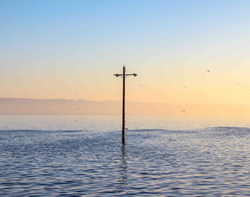Alexander C. Kaufman* says rising sea levels are putting at risk thousands of kilometres of underground infrastructure, threatening to bring down the internet.

Photo: Giovanni Arechavaleta
The labyrinth of cables and hardware that supports the internet is likely to be flooded with saltwater as sea levels rise over the next 15 years, submerging thousands of kilometres of underground infrastructure, particularly in coastal cities.
A peer-reviewed study, presented earlier this month at a conference of internet researchers in Montreal, estimates that in the US alone 6,545 km of fibre optic cables will be underwater and 1,101 hardware centres will be surrounded by water if seas surge by 30 cm over the next decade and a half.
Buried cables, unlike the transoceanic conduits that ferry data from continent to continent, are not waterproof, meaning those figures could skyrocket by the end of the century if worst-case scenario projections of 1.8 m of sea level rise prove accurate.
“We have to start working on all the mitigation efforts today,” said Ramakrishnan Durairajan, an author of the study and a computer scientist at the University of Oregon.
The researchers identified the locations of the most vulnerable hardware by comparing the Internet Atlas, a global map of the internet’s physical infrastructure, with sea level rise data from the US National Oceanic and Atmospheric Administration.
Dense coastal metropoles are at the greatest risk from internet outages from flooding.
One US provider, CenturyLink, said it already designs its networks to “allow for alternate traffic routing during maintenance or natural disasters.”
“We will continue to take all potential risks, such as the effects of climate change, into consideration in our ongoing planning and deployment of existing and new facilities,” Mark Molzen, a company spokesman, said.
Weather events made worse by climate change have already caused internet outages.
In 2012, internet outages across the US doubled when Superstorm Sandy struck New York, flooding telecom centres.
In 2015, airconditioners failed at Australia’s second-biggest internet provider during a heatwave, forcing the company to shut down servers.
Last year, nearly 1 million people in Florida lost internet for weeks after Hurricane Irma made landfall.
Durairajan said the research did not consider the heightened risk of sea level rise combined with another event, such as a major storm.
Nor did it calculate the value of all the at-risk infrastructure in dollars.
But Durairajan said the study makes clear the need to prepare for protecting national infrastructure during disasters in major regional hubs.
“We hope to continue working on this [to answer questions such as] what is the effect of multiple such calamities on the internet?” he said.
“You could imagine this becoming a cascading issue.”
* Alexander Kaufman is a climate, environment and business reporter at HuffPost in New York. He tweets at @AlexCKaufman.
This article first appeared at www.huffingtonpost.com.au.





